Sky islands and tropical alpine sunflowers at risk of disappearing

As temperatures rise around the world, many species may escape the heat by migrating to higher elevations. But what will happen to those species that are already as high as there is to go?
A new study in Frontiers in Ecology and Evolution is among the first to predict the vulnerability of ecosystems in the Andes to both climate change and human activities. The researchers focused on biodiversity hotspots, called Páramos, and the most diverse plant species of these ecosystems—-relatives of the sunflower in the genus Espeletia. The researchers' models predict that these habitats will shrink substantially in the next 30 years without conservation efforts. Beyond this potential loss of biodiversity, this is likely to negatively impact the human populations that rely on these ecosystems as well.
"Páramos are one of the fastest evolving biodiversity hotspots on earth and they are one of the most threatened," says co-leading author Dr. Andrés Cortés, of the Colombian Corporation for Agricultural Research, together with Dr. Santiago Madriñán, who is an expert on Páramos at the Universidad de los Andes in Colombia. "Páramos are also the main water supplier of wetland ecosystems and densely populated areas, hence, disregarding the future of the Páramos may jeopardize overall food and water safety in the northern Andes."

Páramos, or "sky islands," are tropical high elevation ecosystems that are above the tree line, ca. 2,800—5,000 m above sea level, but that are still below the permanently frozen mountaintops. Over a few millions of years, the species that inhabit these areas have adapted to extreme variations in temperature, water availability and sunlight exposure.
As a result of these conditions, there are now over 3,000 plant species throughout the South American Páramos and these areas continue to be among the fastest evolving ecosystems in the world. But scientists are only beginning to understand whether these species can evolve fast enough to keep up with climate change.
The team selected Espeletia as a representative genus because it is one of the most diverse and successful plant genera endemic to the Páramos, as well as iconic with its unbranched trunk topped with a rosette of leaves. The researchers used the most up-to-date computer modelling to predict what the distribution of 28 species of Espeletia would look like in 2050.

By adding in other factors such as nature reserves, surrounding forests, population density, agriculture and mining, the researchers found that some Páramos were particularly vulnerable and they also confirmed the limited opportunities for Espeletia species to migrate or adapt.Future work is needed to understand the role of microhabitats and other species, but these findings highlight the importance of protecting these areas.
"We hope that our findings might assist future conservation efforts, such as promoting more sustainable land uses by empowering local communities and developing ecotourism, which are also essential to relieve human impact on tropical-alpine plant diversity in the northern Andes," says the team. "In the most pessimistic scenario, if Espeletia and Páramos were lost forever, science would lose an underexplored laboratory to study evolution happening at incredible rates—it would be just as if The Galápagos Islands disappeared."
More information: Jhon B. Valencia et al, Climate Vulnerability Assessment of the Espeletia Complex on Páramo Sky Islands in the Northern Andes, Frontiers in Ecology and Evolution (2020). DOI: 10.3389/fevo.2020.565708
Journal information: Frontiers in Ecology and Evolution
Provided by Frontiers

















